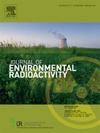塞米巴拉金斯克试验场地上核试验和热核试验沉降物尘流土壤中90Sr/137Cs活性比的比较
IF 2.1
3区 环境科学与生态学
Q3 ENVIRONMENTAL SCIENCES
引用次数: 0
摘要
核武器试验在塞米巴拉金斯克试验场(STS)留下的放射性污染是一种长期遗留问题和公共卫生危害,90Sr和137Cs放射性核素是裂变产物,由于锶与钙、铯与钾的相似性,具有相对较高的生物利用度。本文研究了1951年9月24日进行的38kt地面核试验(南羽)和1953年8月12日进行的400kt第一次热核试验(东南羽)在试验场试验场中心收集的沉降物羽中表层土壤(0-5 cm)中90Sr和137Cs活性浓度、90Sr/137Cs比值和土壤粒度组分。从我们的研究结果来看,放射性137Cs污染的活动水平在两个羽流中是相当的,但东南羽流的90Sr水平更高。据估计,南羽流的90Sr/137Cs比值在0.4 ~ 1.7之间,而热核试验羽流的比值在1.1 ~ 5.4之间,这被认为是由于不同类型和当量的核荷引起的。东南羽流的90Sr/137Cs比值随粒径从1000 μm减小到40 μm而减小。在250 ~ 1000 μm范围内,活性浓度比高达6.2。在南部羽流中,放射性核素集中在250 ~ 100 μm的颗粒中,放射性核素的比例没有随颗粒大小变化而变化。南部羽流的最大90Sr/137Cs比值不超过3,细粒羽流的最大90Sr/137Cs比值小于1。因此,放射性核素在土壤颗粒大小部分的分布与放射性颗粒的其他精确诊断方法相结合,可以帮助确定放射性沉降物的来源和性质,并评估放射性沉降物随时间的转变程度,以及放射性污染对各种环境成分的长期影响。本文章由计算机程序翻译,如有差异,请以英文原文为准。
Comparison of 90Sr/137Cs activity ratios in the soil of fallout plumes from aboveground nuclear and thermonuclear tests at the Semipalatinsk Test Site
Nuclear weapons testing leaves behind radioactive contamination as a long-lasting legacy and public health hazard at the Semipalatinsk Test Site (STS) and the 90Sr and 137Cs radionuclides are fission products with relatively high bioavailability due to the similarity of strontium to calcium and cesium to potassium. This study investigated 90Sr and 137Cs activity concentrations and 90Sr/137Cs ratios in topsoil (0–5 cm) and soil particle-size fractions collected in the fallout plumes from the 38 kt aboveground nuclear test conducted on September 24, 1951 (the Southern plume) and the 400 kt first thermonuclear test on August 12, 1953 (the Southeastern plume) at the center of the Experimental Field test site of the STS. From our findings, activity levels of radioactive 137Cs contamination were comparable in the two plumes, but the Southeastern plume had higher 90Sr levels. The estimated 90Sr/137Cs ratios were between 0.4 and 1.7 for the Southern plume, while the ratios of thermonuclear test's plume ranged between 1.1 and 5.4, which are assumed to be due to the different types and yields of the nuclear charges. For the Southeastern plume, the values of the 90Sr/137Cs ratios in soil particle-size fractions reduce as the size of the fractions decreased from 1000 to 40 μm. High activity concentration ratios of up to 6.2 were observed for fractions ranging from 250 to 1000 μm. In the Southern plume, radionuclides were concentrated in the 250-100 μm fraction, without variability of the radionuclide ratios based on particle-size fractions. The maximum 90Sr/137Cs ratio for the Southern plume did not exceed 3, and was less than 1 for finer fractions. As a result, the distribution of radionuclides by particle-sized fractions of soils in combination with other precision diagnostic methods of radioactive particles can help to identify sources and nature of radioactive fallout and to assess the degree of transformation of radioactive fallout over time, as well as the long-term effects of radioactive contamination on various environmental components.
求助全文
通过发布文献求助,成功后即可免费获取论文全文。
去求助
来源期刊

Journal of environmental radioactivity
环境科学-环境科学
CiteScore
4.70
自引率
13.00%
发文量
209
审稿时长
73 days
期刊介绍:
The Journal of Environmental Radioactivity provides a coherent international forum for publication of original research or review papers on any aspect of the occurrence of radioactivity in natural systems.
Relevant subject areas range from applications of environmental radionuclides as mechanistic or timescale tracers of natural processes to assessments of the radioecological or radiological effects of ambient radioactivity. Papers deal with naturally occurring nuclides or with those created and released by man through nuclear weapons manufacture and testing, energy production, fuel-cycle technology, etc. Reports on radioactivity in the oceans, sediments, rivers, lakes, groundwaters, soils, atmosphere and all divisions of the biosphere are welcomed, but these should not simply be of a monitoring nature unless the data are particularly innovative.
 求助内容:
求助内容: 应助结果提醒方式:
应助结果提醒方式:


